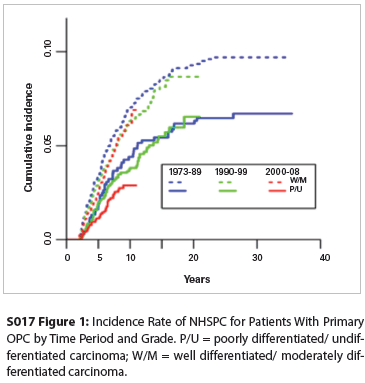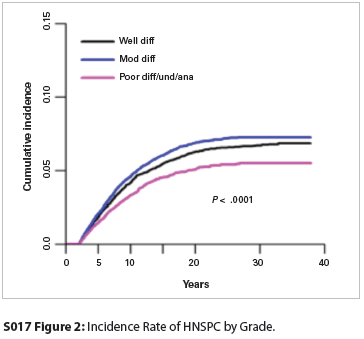(S017) Long-Term Outcome of Intensity-Modulated Radiation Therapy in Pediatric Craniopharyngioma
The purpose of this study is to report the long-term progression-free survival (PFS), overall survival (OS), and late-toxicity outcomes in pediatric patients with craniopharyngioma who have been treated with IMRT.
S017 Figure 1

S017 Figure 2

Brad J. Greenfield, MD, Mehmet F. Okcu, MD, MPH, Bin S. Teh, MD, Patricia A. Baxter, MD, Murali M. Chintagumpala, MD, Robert C. Dauser, MD, Snehal S. Desai, MD, Arnold C. Paulino, MD; Baylor College of Medicine; Texas Children’s Cancer Center; Methodist Hospital; UT MD Anderson Cancer Center
Purpose: Although craniopharyngioma is a histologically benign tumor, it is associated with long-term morbidity, secondary to tumor location and treatment. This tumor can present with both cystic and solid components, and response to radiotherapy (RT) for each component may be different. Intensity-modulated radiation therapy (IMRT) may be able to reduce long-term complications of treatment by reducing high doses of RT to the surrounding normal structures. The purpose of this study is to report the long-term progression-free survival (PFS), overall survival (OS), and late-toxicity outcomes in pediatric patients with craniopharyngioma who have been treated with IMRT.
Materials and Methods: From 1996 to 2006, 24 children with craniopharyngioma were treated with definitive (13 patients) or salvage (11 patients) IMRT at one institution. The median age at IMRT was 8 years, with an equal gender distribution. Prior to IMRT, surgical intervention included biopsy (5), subtotal resection (18), and gross total resection (1). The clinical target volume encompassed the tumor plus a 1-cm margin. The median prescribed dose was 50.4 Gy (range: 49.8–54 Gy). Median follow-up after IMRT was 107 months.
Results: The 10-year OS rate was 84%, while the 10-year PFS was 63%. The 10-year cystic and solid tumor PFS rates were 70% and 90%, respectively. Eight patients had cystic progression (median: 12 mo) and two patients had solid progression (median: 41 mo), all requiring surgical interventions. There was no difference in OS or PFS, regardless of whether definitive or salvage IMRT was performed. Prior to IMRT, 17 (71%) had endocrine deficiency, including 13 with panhypopituitarism. At the last follow-up, 21 (88%) had panhypopituitarism. Diabetes insipidus (DI) was seen in all patients prior to salvage RT; another five patients developed DI after IMRT. Eight had visual deficits, seven had preexisting visual field deficits prior to IMRT, and two had worsening visual deficit after IMRT. Other late toxicities included two cerebrovascular events (one in a patient with known Moyamoya syndrome prior to IMRT), obesity (9), and seizure disorder (4). One patient developed myelodysplastic syndrome at 6 years after IMRT.
Conclusions: Treatment with IMRT provides local control and survival rates comparable with 2-dimensional and non-IMRT 3-dimensional techniques. Endocrine and visual problems were common. Many patients had preexisting morbidity prior to starting RT.
Proceedings of the 96th Annual Meeting of the American Radium Society - americanradiumsociety.org